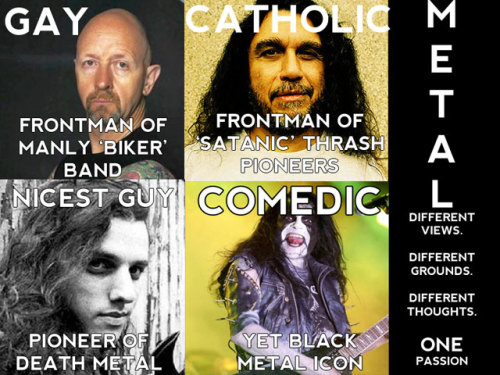There is a continual competition among each successive generation of metal bands everywhere to play heavier, darker, faster and/or more evil-sounding music than their predecessors. It is because of this persistent phenomenon in metal music that the loosely named "extreme metal" sub-genres were born. Within this vague umbrella classification are a diaspora of sub-genres that polarize metal fans themselves. Some love the distinction that the label of "death metal" (as an example) gives it from thrash metal, black metal, power metal, folk metal, etc. Some feel that the sub-genre labels are excessive and contrived, not serving any purpose other than to unnecessarily divide adherents of all music that is considered metal.
Each sub-genre has taken on its own peculiarities and styles, both auditory and visual, and sometimes ideological. Speed metal and thrash metal embraced the idea of putting lightning-fast and crunching guitar riffs on a pedestal, appealing mostly to the similarly energetic and turbulent youth of its heyday and the working class that often were looking for a good time with a beer in hand. Black metal, perhaps the most controversial sub-genre to the public eye (though it's not often that that eye is turned on the reclusive niche), is often thought of as being characterized by the sound of tremolo picking, heavy distortion, shrill vocals and a sustained assault on the uninitiated ear by sustained and rapid blast beat drumming. The controversy associated with black metal comes from the association of the sub-genre with Satanic lyrics and actual crimes committed by some of its musicians including murder of fellow musicians and arson of churches. Death metal, considered by some to be on the opposite side of the spectrum to black metal and by some to belong side-by-side with black metal as "extreme metal", focuses on low, growled vocals, a mixture of the guitar styles from thrash and black metal, and often complex compositions that stand as contradiction to the misconception that metal is for unsophisticated members of what is considered the lowest rungs of society (criminals, shady characters and uneducated degenerates, essentially).
These are only a few of the sub-genres that have come into being over the years, and are themselves subject to further subdivision by those who deem it appropriate.
But in contrast to the idea of rigid conformity to convention and in the spirit of being and expressing one's true self in spite of all other considerations, there are plenty of bands that refuse to be classified under the complex and often confusing sub-genre system, and merely consider themselves to play "metal". As such it is important to remember that enjoyment of the music is the ultimate good in the end.


No comments:
Post a Comment